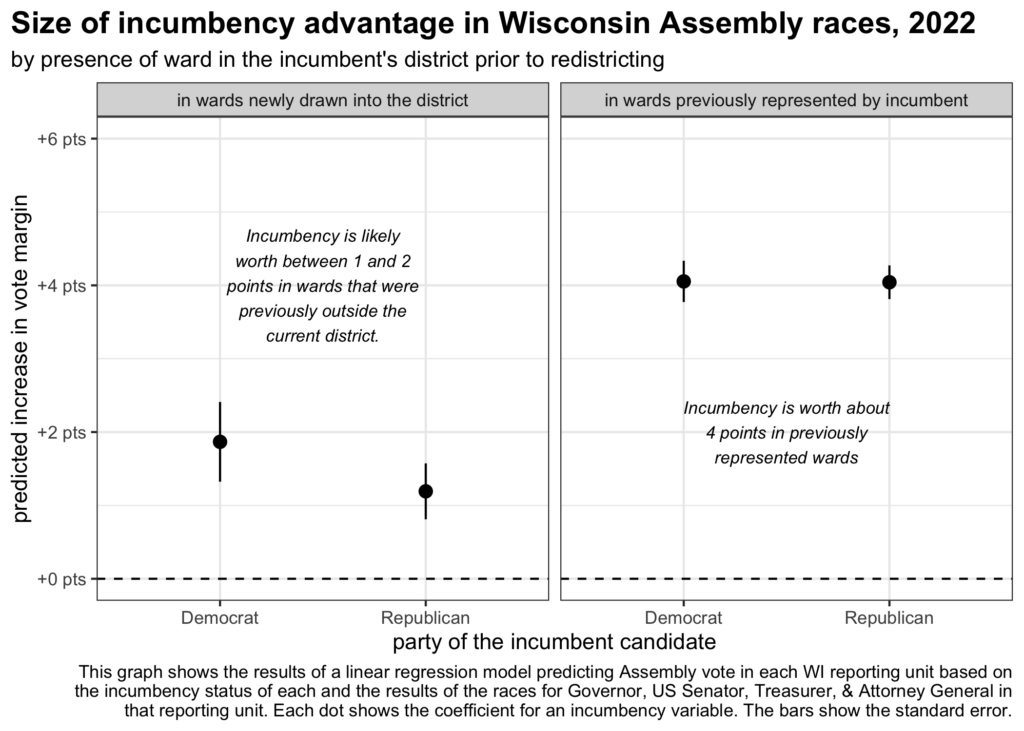Incumbency advantage is not dead yet, despite the increased nationalization of down ballot elections. Many electors vote a straight ticket, but incumbents of both parties do measurably better than non-incumbents in similar races. This blog post considers the size and impact of incumbency advantage in Wisconsin’s 2022 Assembly races. My analysis finds that candidates running for reelection in wards they already represented improved their vote margin by about 4 points over what we’d expect in an open race.
Incumbents have two main advantages over a typical challenger. We expect them to run better campaigns due to having more experience and resources. Voters are also usually more familiar with them, thanks to years of official mailings, public appearances, and yard signs.
Because the past election took place immediately after redistricting, it offers a once-in-a-decade opportunity to measure the performance of incumbents in two situations. Prior to the 2022 election, the boundaries of each Assembly district were tweaked to equalize population. Consequently, when incumbents ran for reelection, they did so in districts containing areas they previously did not represent. In these new wards, we expect the incumbents to benefit from superior campaign organization, but not from legacy name recognition.
Seventy-three of Wisconsin’s 99 Assembly seats were contested by both parties. Of those, 37 featured a Republican incumbent, 19 a Democratic incumbent, and 17 were open races.
For each reporting unit used in the 2022 election, I identified its Assembly district under the previous map, replaced by the latest redistricting. I then compared the previous district assignment with the current (post-redistricting) district assignment, removing those units which were split by the previous boundaries. Then, I determined the incumbency status of each reporting unit. The totals are shown in the table below.
Forty-eight thousand voters found themselves drawn into a new district where the Democratic incumbent was running for reelection. Likewise, 116,000 voters found themselves transferred into a new district featuring a Republican incumbent seeking reelection.
| Incumbent status | # of reporting units | # of voters |
| Dem incumbent, redistricted | 71 | 48k |
| Dem incumbent, same district | 475 | 355k |
| Open race (no incumbent) | 545 | 395k |
| Rep incumbent, redistricted | 188 | 116k |
| Rep incumbent, same district | 1,180 | 784k |
I then constructed a regression model to test what influence, if any, each incumbency status might have on the outcome of the Assembly race. My regressors included dummy variables for incumbency status along with the results of the races for Governor, US Senate, Treasurer, and Attorney General. The intercept (or base case) is an open race with no incumbent in which each statewide election resulted in a tie. (See Appendix for details.)
The graph shows the results of that regression for each incumbent situation. Democrats and Republicans running for reelection in wards they already represented each benefited from an incumbency advantage of about 4 points. This means that in a seat which seems 50/50 based on the way it votes in statewide elections, we’d expect an incumbent Democratic or Republican candidate to win about 52% of the vote.
Incumbency advantage also exists for those incumbents in their district’s new wards, but it is much smaller. The model predicts a 1.2-point advantage for Republicans and a 1.8-point advantage for Democratic incumbents over their expected performance in an open race. But the difference between these two figures is not statistically significant.

In the Wisconsin Assembly, incumbents enjoy a noticeable advantage over the expected performance of candidates from the same party in an open race. The effect is statistically significant even in wards which weren’t previously part of that incumbent’s district, but the magnitude of the advantage is over twice as large in wards which were previously represented by the incumbent.
This supports the idea that slightly more than half of incumbency advantage is thanks to familiarity with the candidate, while the rest comes from superior campaign organization. As I’ve written elsewhere, Wisconsin Assembly Democrats significantly lagged the performance of Gov. Tony Evers. The advantages of incumbency explain much of that. Although, individual Republican and Democratic politicians benefit about equally, the Republicans field many more incumbent candidates in any given year. Incumbency is still a boon to the party protecting its majority.
Appendix
In the following formula, GOV means “governor,” USS means “US Senate,” WST means “Treasurer,” and WAG means “Attorney General.” The unit of analysis consisted of all 2,451 reporting units in contested Assembly districts. Because reporting units vary considerably in size, I weighted each by its total number of voters.

================================================
Dependent variable:
—————————-
WSA
————————————————
GOV 0.003
(0.045)
USS 0.700***
(0.044)
WST 0.198***
(0.044)
WAG 0.072*
(0.041)
incumbent_rep_old -4.042***
(0.230)
incumbent_rep_new -1.192***
(0.381)
incumbent_dem_old 4.054***
(0.281)
incumbent_dem_new 1.867***
(0.544)
Constant -0.299
(0.275)
————————————————
Observations 2,451
R2 0.984
Adjusted R2 0.984
Residual Std. Error 111.635 (df = 2442)
F Statistic 18,587.040*** (df = 8; 2442)
================================================
Note: *p<0.1; **p<0.05; ***p<0.01

This is interesting. Thank you. As you note, only 73 of our 99 Assembly districts had two candidates. Of those 73 only 8 were “competitive” (which I define as the candidates vote totals were within 10%, i.e. 55-45) Incumbency is an advantage. Incumbency in a gerrymandered district is even more advantageous. Incumbency did not allow the Republicans to increase their seats in the Assembly from 61 to 64, gerrymandering did.
Let us compare the total votes statewide to the percentage of seats each party obtained. Popular vote: R. 1,350,083; D. 1,124,962, Percentage R. 53.6% to D. 44.6%. Seats won R. 64, D. 35. So out of a 54-45 overall vote the Republicans obtained 64 seats to 35. That result is not even close to the vote total percentages which would call for roughly a 54-45 total. The problems are strangely drawn districts cutting many municipalities in half, rural districts including significant portions of cities thereby rendering those votes irrelevant and dealing with the million people moved into new districts in 2010.